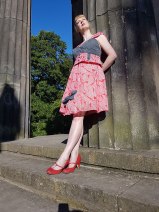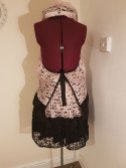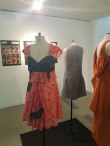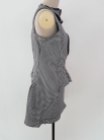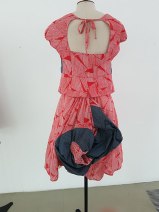I wrote a conclusion for each final garment and noted how the design tied in with my theme of Metamorphosis. But I wanted to also add an overall summary of the project as a whole.
This was always intended as a purely experimental process (and collection). The final designs weren’t supposed to be season-based, or look like they were part of a cohesive collection. This was purely an exercise in recycling, to see how existing garments could be used to inspire different designs, and even how to make use of existing features within an original garment.
The entire collection consists of the following recycled garments:
- Six men’s shirts
- One hounds tooth dress
- One lace maternity dress
- One black gathered/layered skirt
- One red summer dress
- One cream wrap-over dress
The collection is zero waste with minimal ‘new’ materials introduced into the garments. The new materials used consisted of things such as, interfacing, ribbon for hanging loops and waistbands and a few vintage buttons.
The only downside to this project adhering to my ‘zero-waste’ aims, was the amount of hours I spent unpicking garments. If this project had been about minimal waste I could have saved time by simply cutting off seam allowances as a faster way to get started draping designs on the stand.
All the designs by the end were stand-draped, so I didn’t get much use out of my drafted blocks, except to occasionally compare them against my draped pattern pieces (to make sure shapes and sizes looked accurate). So, the flat pattern drafting was helpful, but did not speed up the rate in which I made the patterns and final designs. I do, however, love stand draping as a technique. It is a quick and instant way to see a design in 3D, where you can adjust the drape and panels of the garment until the fabric bends to your will!
Overall, I am very happy with the end result and feel incredibly inspired to do more with recycled (including making myself some things from the leftover garments). Not only is this a great way to keep clothing out of landfill, but it is also a good future service for potential clients, by transforming much-loved, but worn garments, into something very different – to extend their life cycle.





















